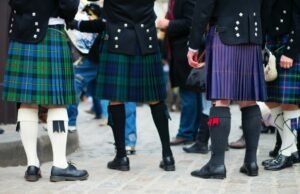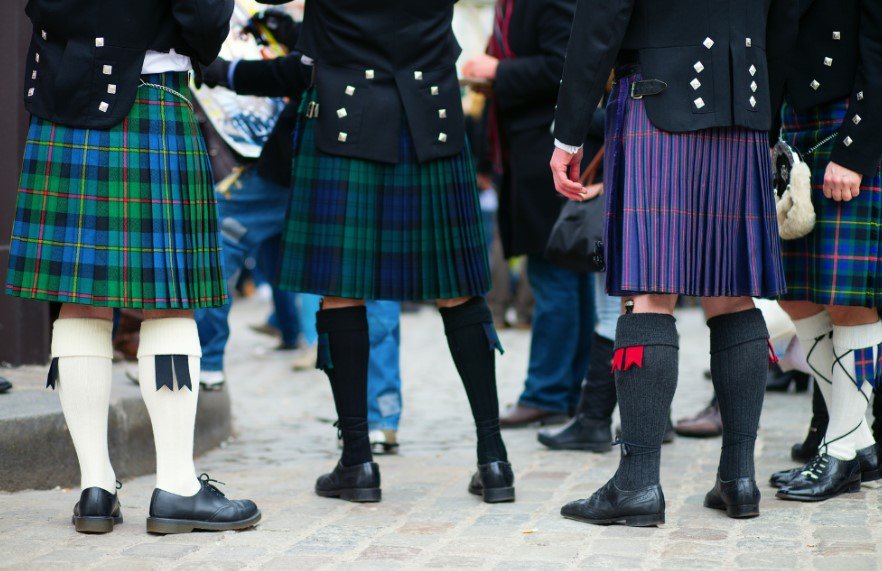When you envision Scotland, what comes to mind? Rolling landscapes, the sound of bagpipes, and, of course, traditional kilts! These iconic garments are more than mere attire; they are vibrant expressions of culture, history, and identity. In this article, we will delve into the significance of traditional kilts, their distinctive features, the narratives behind the tartan, and why they continue to be treasured around the globe.

What is a Traditional Kilt?
Traditional kilts are knee-length, skirt-like garments crafted from tartan fabric, characterized by pleats at the back. Originally donned by men, kilts have become a cherished symbol of Scottish heritage, often associated with pride, valor, and national identity. The tartan patterns, composed of interlacing horizontal and vertical bands in multiple hues, represent different clans and regions throughout Scotland.
The Structure of a Kilt
Understanding the components of a kilt can enhance your appreciation for this timeless garment. A typical kilt comprises several essential elements:
- Fabric: Kilts are traditionally fashioned from wool, which is warm, durable, and breathable. Contemporary kilts may also utilize synthetic materials for ease of maintenance and comfort.
- Pleats: The back of the kilt features deep pleats that allow for unrestricted movement, making it ideal for various activities, from dancing to hiking.
- Waistband: A kilt typically includes a sturdy waistband that sits at the natural waist, providing a secure fit.
- Fastening: Traditionally, kilts are secured with leather straps or buckles, ensuring they remain in place while worn.
The History Behind Kilts
Kilts boast a rich history dating back to the 16th century. Their origins trace back to the Scottish Highlands, where they were initially adopted as a practical garment for Highlanders. The early version, known as the “great kilt” or “feileadh mòr,” was a large piece of woolen fabric that could be wrapped around the body and worn in various styles.
As time progressed, the design evolved into the more tailored kilt we see today, often referred to as the “little kilt” or “feileadh beag.” This evolution made the garment easier to wear and allowed for greater freedom of movement. The kilt became a staple for Scottish men, particularly in the Highlands, where it was not only functional but also a symbol of cultural pride.
The Role of the Kilt in Scottish History
Throughout history, kilts have held significant roles in various events, from battles to celebrations. During the Jacobite risings in the 18th century, the kilt emerged as a symbol of resistance against British rule. Despite the subsequent prohibition of tartan and kilts after the Jacobite defeat at Culloden in 1746, the kilt eventually experienced a revival as a symbol of Scottish nationalism.
Today, kilts are worn with pride during national celebrations, Highland games, and cultural festivals, showcasing Scotland’s rich heritage to the world.
The Tartan: More Than Just a Pattern
One of the most captivating aspects of traditional kilts is the tartan fabric itself. Each tartan pattern tells a tale and holds cultural significance. Different patterns are associated with specific clans, regions, or families, making the selection of tartan a deeply personal choice.
The Significance of Tartan
The intricate designs and colors of tartan are imbued with meaning. Traditionally, the hues used in tartans were derived from natural dyes, which could vary depending on the region. Each clan’s tartan represents its unique identity, and wearing a particular tartan signifies pride in one’s lineage.
For those seeking to connect with their Scottish roots, choosing a kilt in their family’s tartan is a wonderful way to honor their heritage. Many Scottish families continue to uphold the tradition of wearing their clan’s tartan during significant events, reinforcing a sense of belonging and identity.
How to Wear a Traditional Kilt
Wearing a traditional kilt is an experience in itself, and getting it right can enhance your enjoyment and confidence. Here are a few tips to help you look your best:
- Kilt Hose and Shoes
Pair your kilt with knee-high socks, known as kilt hose, often worn with decorative garters. Classic leather shoes or brogues complete the ensemble and provide a polished appearance. Opt for shoes that are comfortable, especially if you’ll be wearing your kilt for an extended period. - Belt and Buckle
A wide belt not only adds a stylish flair but also helps keep the kilt in place. The belt should be worn at the waistline, ensuring a snug fit. A decorative buckle can enhance the overall look, often featuring symbols or emblems that reflect your heritage. - Sporran
The sporran is a small pouch worn at the front of the kilt, serving both functional and decorative purposes. Traditionally crafted from leather or fur, the sporran is ideal for carrying essentials like a wallet, keys, or even a small flask. It comes in various styles, ranging from simple to ornate, allowing you to express your personality. - Jacket
For formal occasions, a smart jacket is essential. The Prince Charlie jacket and the Argyle jacket are popular choices that beautifully complement the kilt. Pairing your kilt with a waistcoat can add an extra layer of sophistication. - Accessories
Don’t overlook accessories! A kilt pin, worn on the front apron of the kilt, adds a decorative touch while keeping the fabric in place. You might also consider a cap, such as a glengarry or a tam o’shanter, to complete your traditional look.
When to Wear a Kilt
Traditional kilts are versatile garments suitable for various occasions. Here are some popular times to don a kilt:
- Weddings
Kilts are a favored choice for grooms and wedding parties, especially in Scotland. They add a unique flair to the celebration, allowing the wedding party to stand out while honoring cultural traditions. - Highland Games
Participating in or attending Highland games is a fantastic reason to wear a kilt. These events celebrate Scottish culture through traditional sports, dancing, and music, making it an ideal occasion to showcase your heritage. - Festivals and Parades
Many towns and cities host Scottish festivals, parades, and cultural events. Wearing a kilt at these gatherings not only connects you with your roots but also allows you to partake in the celebration of Scottish culture with others. - Family Gatherings
Family reunions and gatherings are excellent opportunities to wear a kilt, especially if your family has a unique tartan. It’s a way to honor your ancestors and create lasting memories with loved ones.
Why Choose Traditional Kilts?
Investing in a traditional kilt means embracing a piece of history and culture. Here are several reasons to consider adding a kilt to your wardrobe:
- Cultural Connection
A traditional kilt is a beautiful way to connect with Scottish heritage, whether you’re of Scottish descent or simply appreciate the culture. Wearing a kilt can spark conversations about your ancestry and allow you to share stories with others. - Unique Fashion Statement
Kilts are distinctive garments that make an impression. Whether you’re attending a formal event or a casual gathering, a kilt stands out and showcases your personal style. With a variety of tartans and styles available, there’s a kilt for everyone. - Versatility
Traditional kilts are surprisingly adaptable. While often associated with formal occasions, they can also be worn in casual settings, such as picnics or family gatherings. Pair a kilt with a simple shirt for a laid-back look, or dress it up for a more sophisticated appearance. - Comfort and Freedom of Movement
The design of the kilt allows for a full range of motion, making it comfortable to wear during various activities. Whether you’re dancing at a ceilidh or hiking in the Scottish Highlands, a kilt offers both style and practicality. - Quality Craftsmanship
Traditional kilts are often handcrafted from high-quality materials, ensuring durability and comfort. Investing in a well-made kilt means you’ll have a garment that can be passed down through generations, becoming a treasured family heirloom.
Conclusion
Traditional kilts are more than mere garments; they embody a profound sense of pride, identity, and cultural heritage. With their stunning tartan patterns and rich history, these iconic garments remain a cherished aspect of Scottish culture. Whether you’re Scottish or simply appreciate the beauty and tradition of the kilt, wearing one is a wonderful way to honor history while making a bold fashion statement.
So, if you’re ready to add a touch of heritage to your wardrobe, consider investing in a traditional kilt. It’s not just clothing; it’s a connection to history, family, and culture that you can wear with pride. Whether you choose a classic tartan or a contemporary design, a kilt is sure to bring joy and a sense of belonging to your life.


